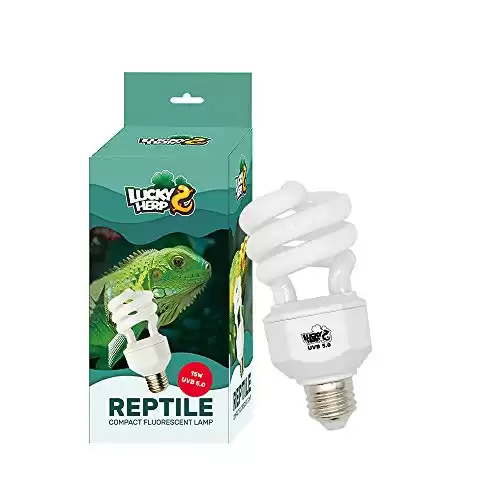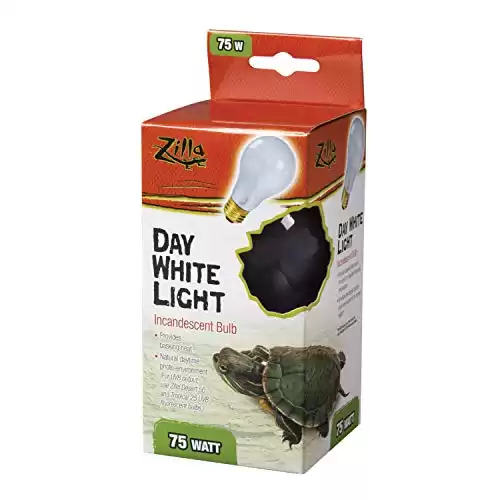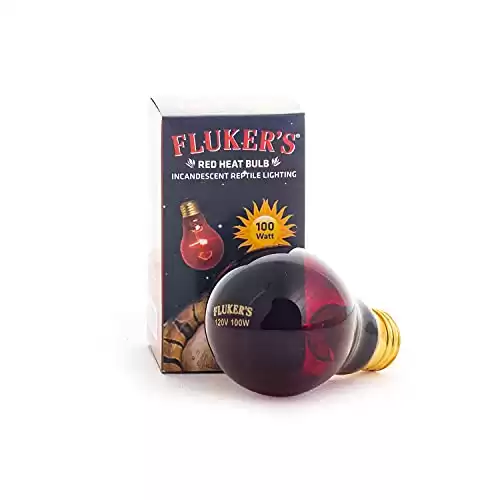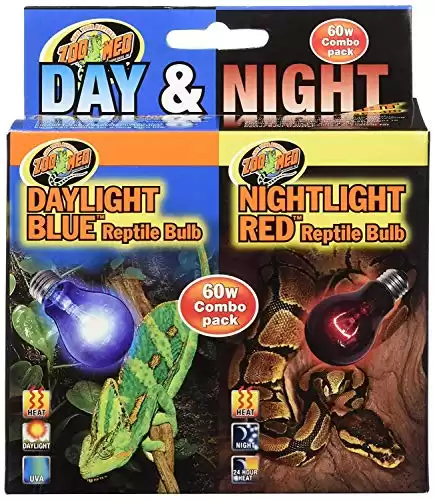A lot of people believe leopard geckos are nocturnal reptiles that don’t need any type of lighting in their tanks. But in fact, leos are a crepuscular species, which means they are the most active during dawn and dusk.
To help your pet reptile maintain a healthy circadian rhythm, you need to find the best lights for your leopard gecko. Read on for our top 5 lights for geckos plus tips on how to create the best light set up for your pet.
Why Do You Need a Light for your Leopard Gecko?
While leopard geckos spend the better parts of their days snoozing, they are surprisingly in tune with their environment. Like all other animals, leos know how to tell night from day. Their survival in the wild depends on this ability.
Though your leopard gecko is no longer living in the wild, it’s your job as an owner to provide them with a setup that mimics a leopard gecko’s natural habitat and supports a day-night cycle.
Leopard geckos have special lighting requirements as they are active at night and in the early morning hours. They don’t bask in the heat all day like bearded dragons or many other reptiles.
TOP PICK: Lucky Herp UVA UVB Reptile Light 5.0
If you are looking for affordable leopard gecko lighting that emits both light and heat, then I recommend the Lucky Herp UVA UVB Reptile Light 5.0. Easy to mount and compatible with all standard US size sockets, this fluorescent lamp is ideal for all leopard gecko tank setups. Best of all, this light can provide up to 8,000 hours of use, so you won’t need to replace it often.
While UVB isn’t strictly necessary, recent studies have shown that leopard geckos benefit significantly from lower intensity UVB lighting. Even though leopard geckos are most active at dawn and dusk, they are still exposed to small amounts of UVB in the wild. Therefore, it’s safe to assume they will do better with at least some exposure to UVB light in captivity.
Presenting… The Best Lights for Leopard Geckos
| Product Image | Product Name / Primary Rating / Pros | Primary Button |
|---|---|---|
|
||
|
||
|
||
|
||
|
- Reliable source of heat and UVB lighting
- Easy to mount and works with standard-sized electrical sockets
- Long-lasting and doesn’t need to be replaced often
- Doesn’t produce harmful UVC light
- Generates both light and heat
- Full-spectrum lighting intensifies the natural colors of the environment and your reptile
- Bright white light simulates the sunlight in the leopard gecko's natural environment
- Energy efficient and long-lasting so it doesn't need to be replaced often
- Provides the infrared light leopard geckos need to regulate their temperature
- Serves as a night light and a reliable source of heat
- Available as a 75-watt bulb, which is ideal for most enclosures
- Gives off enough light for you to view your gecko during the night
- Gives off blue light for nighttime viewing
- High LED output generates bright daytime light that simulates natural sunlight
- Can be adjusted to fit tanks of different sizes
- LED panels are replaceable, and you can easily change them when they burn out
- Contains both night and day lights which also emit heat
- Red light is made from genuine red glass and can be used as a 24-hour heat lamp
- Soft blue light simulates natural sunlight and is gentle on a reptile's eyes
- Both bulbs last for up to six months of continuous use
Listed below you will find in-depth reviews of gecko lighting that can be mounted on any type of gecko tank or enclosure.
We’ve also included the key features, pros, and cons of each light bulb.
1. Lucky Herp UVA UVB Reptile Light 5.0
The Lucky Herp UVA UVB Reptile Light 5.0 is designed for tropical and sub-tropical species. That said it also happens to generate the ideal amount of UVB light for most common species of pet geckos.
This compact fluorescent lamp is designed to emit both light and heat without producing any harmful UVC.
Easy to mount and compatible with all standard US size sockets, this fluorescent lamp is ideal for all leopard gecko tank setups. Best of all, this light can provide up to 8,000 hours of use, so you won’t need to replace it often.
Key Features
- Delivers 5% UVB and 30% UVA output
- Fits a standard size E26 socket
- Lasts up to 8,000 hours of continuous use
Made to emit both heat and UVB rays, this Lucky Herp reptile bulb produces just enough UVB to make it safe for leopard geckos. While many people assume that geckos don’t need UVB lights to stay healthy, leos use and benefit from UVB light when it’s available to them. The right amount of UVB light encourages the production of vitamin D3 and
The bulb’s special glass tube is designed to produce a stable UVB output. Also, the fading rate of UVB is also low, so you won’t have to replace your gecko lighting that often.
The thing I like the most about this particular light is that you can use it with all kinds of different tank setups. This particular leopard gecko lighting setup is available in several different options that deliver 10% UVB, though 5% is sufficient for most leopard geckos.
Pros
- A reliable source of heat and UVB lighting for pet leopard geckos
- Easy to mount and works with standard-sized electrical sockets
- Long-lasting and doesn’t need to be replaced often
- Doesn’t produce harmful UVC light
Cons
- It has to be turned off at night. That means you’ll need an additional heating source to keep your gecko’s tank warm if your home’s temperatures drop below 70F or so.
Overall, the Lucky Herp UVA UVB Reptile Light 5.0 is a great option if you’re looking for a daylight and heat bulb for a leopard gecko.
2. Zilla Reptile Terrarium Heat Lamp Incandescent Bulb, Day White
Key Features
- Available as a 75-watt bulb, ideal for heating larger enclosures
- Made from glass containing neodymium phosphors
- Full-spectrum lamp
This reasonably priced Zilla Incandescent Bulb is a great option if you are looking for a full-spectrum lamp that emits energy across all visible wavelengths. Made to stimulate the natural daytime environment of both desert and tropical reptile species, this bulb generates heat and bright white light that won’t irritate your gecko’s eyes.
This bulb is available in 75 watts, which is ideal for leopard gecko tanks of various sizes. Made from glass containing neodymium phosphors, this light produces bright, white light that mimics your pet reptile’s natural environment. Since this bulb is made from heavy-duty filaments, it tends to last longer than other incandescent bulbs.
Pros
- Generates both light and heat
- The full-spectrum lighting intensifies the natural colors of the environment and your reptile
- The bright white light simulates the sunlight in the leopard gecko’s natural environment
- Energy efficient and long-lasting so it doesn’t need to be replaced often
Cons
- This lamp may not be able to heat up the edges of a larger leopard gecko tank
All in all, the Zilla Reptile
3. Fluker’s Red Heat Bulb, Incandescent Reptile Lighting
Fluker’s Red Heat Bulb is a great option if you are looking for night lighting for a leopard gecko. Unlike daytime bulbs, this light isn’t made to simulate daylight. Instead it gives you a chance to observe your leopard gecko during the night, which is when they are the most active. It’s especially great if the air temperature in your home is too cold at night for your gecko.
Key Features
- Available in 75 watts
- Provides radiant heat
- Works with any UL-approved light fixture
Fluker’s Incandescent Reptile Lighting is designed to provide the perfect low light heat for your leopard gecko. Besides heating the entire
The best thing about this night light is it is low enough not to disturb your pet’s nighttime activities or disturb your sleep. While leopard geckos might not see red, they can still see light, so don’t leave the lamp on for more than a few hours every night (unless temps in your home drop below 70F or so).
While many red lights are meant to stay running 24 hours a day, Fluker’s recommends a 12-hour day and 12-hour night light cycle. This means you should use a daytime light during the day and a red light only for a few hours per night.
Pros
- Provides the infrared light leopard geckos need to regulate their temperature
- Serves as a night light and a reliable source of heat
- Available as a 75-watt bulb, which is ideal for most enclosures
- Gives off just enough light for you to view your pet gecko during the night
Cons
- If not packed or handled properly during shipping, these bulbs can arrive damaged
Overall, Fluker’s Red Heat Bulb Incandescent Reptile Lighting is a great choice if you are looking for a reliable heat source and a night light that allows you to view your gecko at night.
4. Zoo Med Reptisun LED Terrarium Hood
The Zoo Med Reptisun LED
Key Features
- Adjusts from 18” to 26” long
- Lasts for up to 20,000 hours of use
- 6,500K daylight high output LEDs
Besides emitting blue and red lights, this light fixture is also capable of generating 6,500 Kelvin daylight high-output LEDs. This simulates the natural lighting found in your gecko’s native environment.
Besides promoting your gecko’s health and natural behavior, this light also promotes the growth of any live plants you may have growing in the
Another great thing about this fixture is that you can change or replace the LED panels whenever you want to. Additionally, thanks to its adjustable rails, this lighting can be mounted on a variety of tank sizes. This particular light can last for more than two years when used and maintained properly.
Pros
- Gives off blue light for nighttime viewing
- High LED output generates bright daytime light that simulates natural sunlight
- Can be adjusted to fit tanks of different sizes
- LED panels are replaceable, and you can easily change them when they burn out
Cons
- A few gecko owners reported that this light couldn’t heat very large-sized tanks, but it generates more than enough heat for 10 to 30-gallon enclosures.
If you are looking for all-in-one lighting for your leopard gecko, the Zoo Med Reptisun LED
5. Zoo Med Day Night Reptile Bulbs Combo Pack
The Zoo Med Day Night Reptile Bulbs Combo Pack is one of the most popular lighting options on the market. Instead of just one daylight bulb, you get two lights, each with their own specific purposes.
If you are still wondering what kind of light leopard geckos need, this pack of two lamps might be the best hassle-free option for you and your pet.
Key Features
- 60 watts
- One daylight blue light bulb
- One red glassheat lamp
This reasonably priced pack contains two light bulbs – one daylight blue bulb and one nighttime red bulb. Each bulb is incandescent, which makes them ideal for leopard geckos. The bulbs won’t damage your gecko’s skin by producing too much heat.
The 60-watt blue daylight bulb generates heat and bright naturalistic lighting that is gentler on your reptile’s eyes compared to regular light bulbs. This bulb is meant to be used during the day and will mimic the lighting in a leopard gecko’s natural environment.
The red bulb is made of real red glass and is designed to work as a night light for viewing and a
Pros
- This pack contains both night and day lights which also emit heat
- The red light is made from genuine red glass and can be used as a 24-hourheat lamp
- The soft blue light simulates natural sunlight and is gentle on a reptile’s eyes
- Both bulbs last for up to six months of continuous use
Cons
- A few owners reported that their bulbs weren’t packed securely and that they arrived broken. You may have better luck purchasing these at your local pet store.
All things considered, the Zoo Med Day Night Reptile Bulbs Combo Pack is an excellent choice if you are looking for reasonably priced and reliable lighting for your leopard gecko’s tank.
Recommended Leopard Gecko Lighting Setup
You want your leo’s lighting setup to simulate their natural environment. This means you want something bright during the day, and minimal lighting at night to keep their natural circadian rhythm.
One important thing to note, though, is that while their lighting needs differ from day to night, leos need heat around the clock. So you need to figure this into your setup.
Setup Option 1: Different Lamps for Day and Night
You can have a basking lamp that gives off lamp and heat during the day, and have a different heat source for the nighttime, like a ceramic
You’ll also need to hook up both of these lamps to a thermostat and/or timer, so you don’t have to worry about switching lamps on and off according to a schedule.
Setup Option 2: Separate Light and Heat Sources
Another option is to have just a light source on during the day and a heat source like a ceramic heat emitter that stays on 24/7. This means you only have to think about keeping your light source on a schedule and not think about your heat source at all.
I would still recommend installing a thermostat for your heat source to help you avoid overheating your leopard gecko’s space, and a timer for your light source to keep your day and night timings.
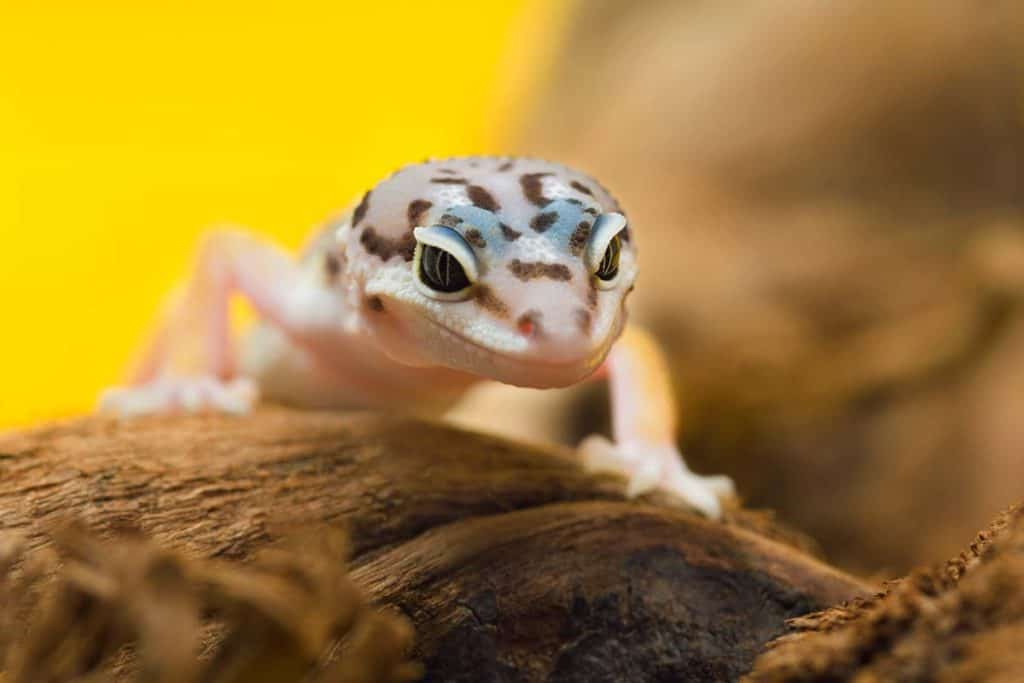
How to Choose the Best Lights for Your Leopard Gecko Pet
There is a lot of misinformation about lights for leopard geckos, and choosing the best fixture is often easier said than done, especially if you are a novice keeper.
Make sure you keep these factors in mind when purchasing lighting for your leopard gecko.
Wattage
“What wattage UVB bulb should I use for my leopard gecko?” Is one of the most common questions first-time gecko keepers ask. The best wattage for leopard geckos is the one that mimics natural light and illuminates your particular tank properly.
Depending on the size and shape of your tank, a low-wattage, full-spectrum bulb ranging from 50 to 75 watts or so should do the trick. For very large enclosures, you may need to use a bulb with a slightly higher wattage, or around 75 to 100 watts.
Leopard geckos don’t require real lighting at night if there is any ambient light in the room, and they don’t need much heat at night, provided temperatures don’t drop below 70F or so.
If the room you keep your gecko’s enclosure in lacks ambient lighting, you can use a low-intensity blue bulb that simulates moonlight and also gives you a chance to view your pet gecko during the night.
Type of Lights
There are several types of lights you may come across while searching for the best light for your pet reptile. Not all bulbs are created equally, and it’s up to you to figure out which one works best for your leo’s tank setup.
Incandescent lights produce a good amount of heat and light and are probably the most affordable type of gecko lighting you’ll come across. Infrared bulbs or ceramic bulbs usually cost more, but they also last a long time and generate a good amount of heat. These types of lamps may require a special socket and are typically made from ceramic or porcelain.
LED lights are also becoming increasingly popular, as they are very efficient and last a long time. Depending on the type, LED lights may or may not give off any heat, so you can use them in combination with other heat sources like under-tank heaters or additional heat bulbs.
Color
The color of the light may not seem like a big deal, but it can become a huge issue if you choose the wrong one. For daytime lighting, a full spectrum white or yellow light is recommended.
Leopard geckos don’t have any light requirements for nighttime. But if there is no ambient light in the room their enclosure is stored in, you can use a blue, red, or black night light to view your pet and offer them a bit of heating if it gets particularly cold at night.
Temperature
Many leopard gecko keepers opt to use a heat mat to maintain the ideal temperature inside the enclosure. If you decide to use a heating mat, you don’t have to worry much about finding a suitable heating bulb. However, if you are looking for an alternative way to heat up your gecko’s tank, you’ll need to look for a light and a heat combination bulb.
Lifespan
How long the light and/or heat bulb will last isn’t something most reptile owners think about when choosing bulbs for their geckos’ tanks. However, the bulb you choose will have to work at least 12 hours per day. Consequently, most leopard gecko lights don’t last nearly as long as standard light bulbs.
If you don’t want to change the light bulbs on your gecko’s tank on a weekly basis, choose a quality bulb with a longer lifespan. Generally speaking, good quality lights should last for around six months of continuous, daily use, and that is something you should consider when shopping for the perfect gecko light.
FAQs on Leopard Gecko Lighting
Do Leopard Geckos Need UVA or UVB Light?
While leopard geckos don’t need UVB light to survive, research has shown that UVA and UVB lights are beneficial for both diurnal and crepuscular reptiles. As a crepuscular species, leopard geckos are exposed to lower levels of UVB light in the wild.
Use a low-intensity UVA/UVB bulb in your leopard gecko’s enclosure and set it on a timer for two hours in the morning and two hours in the evening when they are the most active for best results.
Do leopard geckos need bright light?
During the day, leopard geckos need a bright light that will simulate sunlight in their natural habitat. Choose white or yellow bulbs that closely mimic your gecko’s natural environment to support their circadian rhythm.
Since leopard geckos can tell day from night, they don’t need any light at nighttime, especially if the tank is illuminated by the ambient light in the room. However, if you want to view your gecko during the night when they are the most active, you can leave a blue night light on for a few hours per night.
Does light bother leopard geckos?
Leopard geckos have sensitive eyes, and they aren’t very active during the day. Still, leos usually get at least a small amount of natural sunlight each day in their native habitats, even though they spend most of their days snoozing.
As long as they have plenty of hides inside the tank and you are using a low-intensity light, your gecko won’t be bothered too much.
What wattage bulb should I use for my leopard gecko?
There are many different types of heat and light bulbs ranging in wattage from as low as 15 watts all the way up to 150 watts. When it comes to leopard geckos, generally anything between 60 and 100 watts should do the trick.
The size of your gecko’s tank is an important factor to consider when it comes to wattage. Bigger tanks need higher wattage bulbs and vice versa.
A Final Word About Leopard Gecko Lighting
Contrary to common beliefs, leopard geckos need both heat and proper lighting inside their tanks to stay healthy and thrive. As a crepuscular species, leopard geckos are the most active during dusk and dawn, and they require a balanced day and night schedule to maintain their circadian rhythm. In captivity, none of this is possible without the right lighting setup.
Keeping that in mind, I found that the Lucky Herp UVA UVB Reptile Light 5.0 is the overall best lighting for leopard geckos. Made to generate both heat and light, this affordable light bulb is easy to mount and has a low UVB fading rate. Best of all, this light bulb fits all US standard size electrical sockets.

